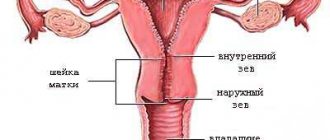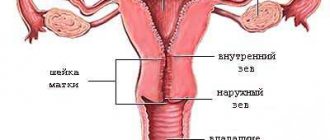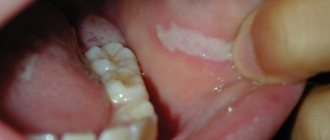Uterus and reproductive organs
The female reproductive system is represented by the mammary glands and pelvic organs.
The main function of these organs is procreation. The gonads produce regulatory substances that affect the development of the reproductive system and other organs. The most important structures are the ovaries, in which the maturation of female germ cells occurs. During ovulation, the reproductive cell leaves the ovarian follicle and enters the fallopian tube. The fusion of male and female reproductive cells in this organ leads to the formation of the rudiment of a new organism. The remaining stages of embryo development occur in the lumen of the uterus. The uterus is a hollow muscular organ located next to the rectum, vagina, ovaries and bladder. The uterine cavity is connected to the external environment through the cervical canal and the vaginal opening. The fallopian tubes allow the fertilized egg to migrate to the uterus. Attachment of the embryo to the inner layer (endometrium) of the organ is necessary for the formation of embryonic organs.
The main part of the cervix is the narrow cervical canal, which connects the vaginal opening to the uterine cavity. This anatomical structure is necessary for the transport of sperm into the fallopian tubes. The mucous membrane of the cervical canal contains a large number of glands that secrete a special fluid. Gynecologists include the functions of cervical mucus as protection against pathogenic microorganisms and ensuring the transportation of sperm. Smooth muscle and elastic fibers of the cervix provide expansion of the cervical canal during childbirth.
Indications
The vaginal part of the cervix is lined with stratified squamous epithelium, which in the cervical or cervical canal is replaced by single-layer columnar epithelium.
In some pathological conditions, keratinization of the stratified squamous epithelium of the vaginal part of the cervix occurs. This disease develops mainly in women aged about 40 years. It accounts for approximately 6% of the total number of cervical diseases. During a gynecological examination, the keratinized areas look like whitish plaques. Hence the name of the disease (ancient Greek leukos - white, plakos - plate, plaque). The following factors predispose to leukoplakia:
- metabolic disorders;
- changes in hormonal levels;
- local inflammatory processes;
- decreased immunity.
Although in most cases it is very difficult to determine the cause of leukoplakia in a particular patient. Leukoplakia is characterized by nonspecific symptoms of pain, burning, and bleeding. Although the disease can be asymptomatic and discovered accidentally during a gynecological examination.
It all depends on the stage of the disease:
- Simple. Single plaque foci are found that do not rise above the healthy mucous membrane and do not merge with each other.
- Warty or verrucous. The plaques rise above the mucosa and merge with each other, giving the mucosa a characteristic lumpy appearance.
- Errosive. Surface defects like erosions appear on the surface of the plaques.
Leukoplakia itself is benign. However, there is a possibility of cancerous tumors forming from plaques. Therefore, this condition should be regarded as precancer. The likelihood of malignancy is especially high with verrucous and erosive leukoplakia. A cause for concern is the rapid growth and fusion of plaques, the formation on their surface of bleeding deep ulcerations, formations in the form of papillae and warts.
But even the usual course of leukoplakia does not exclude malignancy. Therefore, regardless of the stage and course of the disease, destruction and removal of pathological foci are carried out. And one of the methods is electrosurgical coagulation or diathermocoagulation.
Causes
The exact causes of leukoplakia are unknown. Gynecologists associate the etiology of this disease with pathological external and endogenous influences. Thus, a significant increase in estrogen production against the background of progesterone deficiency can trigger the development of the disease. Hereditary factors play an important role in the formation of leukoplakia: certain genetic mutations can cause epithelial changes.
Possible reasons:
- Diseases of the endocrine system. The endocrine glands regulate the development of all organs, including the structures of the reproductive system. The greatest risk of developing cervical leukoplakia is associated with a disorder of the pituitary gland and ovaries. Diseases of the thyroid gland and adrenal glands can also be complicated by damage to the cervix.
- Chronic infections and inflammatory diseases of the pelvic cavity. In particular, human papillomavirus infection directly affects the condition of the cervical epithelium.
- Sexually transmitted infections including chlamydia, gonorrhea and herpes. Sexually transmitted diseases affect the condition of the external and internal genital organs.
- Mechanical damage to the cervical epithelium that occurs during trauma, diagnostic and therapeutic procedures. Artificial termination of pregnancy leads to tissue trauma.
- Mutation of the gene responsible for suppressing the growth of tumor cells. According to research, a mutation in the p53 gene, which controls cell development, leads to impaired tissue growth.
Normally, the outer lining of the cervix is represented by stratified non-keratinizing epithelium. Certain diseases can affect the internal structure of epithelial cells. Changes in the regulation of epithelial cells lead to keratinization and thickening of the outer layer of the membrane. It is assumed that one of the mechanisms of cell changes is the expression of a mutant gene.
Medicines
Photo: kak-bog.ru
In the presence of an infectious disease of bacterial etiology, antibiotics are prescribed, the action of which is aimed at destroying pathogenic microorganisms. As a rule, broad-spectrum antibacterial agents are used, since they are effective against both gram-negative and gram-positive microflora. While taking antibacterial agents, various undesirable effects may appear, but the most common side effects are from the gastrointestinal tract (nausea, vomiting, heartburn, diarrhea). As is known, taking antibacterial agents affects the quantitative composition of the normal microflora of the intestinal tract, which is why in some cases probiotics are additionally prescribed.
In case of herpes infection, acyclovir is prescribed. The dosage of the drug and the frequency of administration are determined by the attending physician, based on the severity of the process and the severity of clinical manifestations. While taking the drug, the following side effects may occur: periodic discomfort in the epigastric region, nausea, occasionally vomiting, increased stool frequency. It is also worth noting that while taking acyclovir, it is important to monitor creatinine and urea levels, since this drug is known to have a detrimental effect on kidney function. Accordingly, people suffering from chronic kidney disease are advised to refrain from using this drug or to more carefully monitor laboratory parameters to assess kidney function.
Antifungal drugs (fluconazole, ketoconazole, itraconazole) have a fungicidal or fungistatic effect and are used for the treatment and prevention of mycoses. The most common undesirable effects that occur while taking antifungal drugs are: periodic discomfort or pain in the abdomen, heartburn, a feeling of bitterness in the mouth, nausea, occasionally vomiting, flatulence, constipation, dry oral mucosa.
In the presence of an infectious-inflammatory disease of the reproductive system, non-steroidal anti-inflammatory drugs (ibuprofen, diclofenac) are prescribed. The mechanism of action is to inhibit the enzyme COX (cyclooxygenase), as a result of which the synthesis of prostaglandins is disrupted. Thanks to this mechanism of action, not only an anti-inflammatory effect is achieved, but also an antipyretic and analgesic effect. Non-steroidal anti-inflammatory drugs should be used with caution by people with gastrointestinal diseases, since long-term use of these drugs, especially in large doses, leads to damage to the mucous membrane of the digestive tract.
Risk factors
In addition to the direct causes of cervical leukoplakia, gynecologists recognize the importance of certain forms of predisposition to the disease associated with heredity, individual history and a woman’s lifestyle.
Known risk factors:
- unprotected sexual intercourse;
- menstrual irregularities;
- drinking alcoholic beverages and smoking;
- radiation therapy of the pelvic organs;
- insufficient intake of vitamins and microelements from food;
- metabolic diseases;
- uncontrolled use of hormonal drugs;
- detection of leukoplakia or cervical carcinoma in a close relative.
Eliminating some of the risk factors listed above is an effective method of preventing the disease.
Classification
There are two main types of cervical leukoplakia, differing in morphological and functional features. Determining the specific type of disease is possible only with the help of histological examination. Different morphological forms of leukoplakia differ in the risk of malignant degeneration.
Forms of the disease:
- Simple leukoplakia, characterized by coarsening of the outer layer of the epithelium and excessive cell division. Significant morphological changes in the cells of the basal layer are not detected.
- Proliferative leukoplakia. This form of the disease is characterized by a violation of cell specialization and the appearance of specific morphological changes. Proliferative leukoplakia is considered a precancerous condition.
Determining the form of the pathology is necessary to select treatment.
Types of leukoplakia
How to treat leukoplakia depends on its type. The disease is dangerous because pathological processes in the epithelium can become malignant and provoke oncological tumors.
Today, medicine distinguishes three categories of leukoplakia.
- Simple. The formations are located flush with the epithelium. They are usually white in color and the changes are benign.
- Proliferative. It is expressed in dense growths rising above the epithelium. There are warty and scaly forms.
- Erosive. Characterized by cracking and bleeding lesions. This form is the most dangerous because the structures contain atypical cells.
Symptoms
In most cases, the disease does not manifest itself symptomatically. In itself, the coarsening of the outer epithelium of the cervix does not lead to dysfunction of the organ, so the pathology can remain undiagnosed for a long time. Typically, leukoplakia becomes an incidental finding during a gynecological examination.
Possible symptoms:
- discomfort during sexual intercourse;
- pain during menstruation;
- bloody issues;
- excess vaginal discharge.
The appearance of frequent uterine bleeding not associated with menstruation and pain may indicate the transformation of leukoplakia into a malignant tumor.
Diagnostics
If risk factors for the disease are detected, you must make an appointment with a gynecologist. During the consultation, the doctor will ask the woman about her complaints and examine her medical history. Then an initial examination of the genital organs is carried out, including palpation examination and the use of mirrors to assess the condition of the cervix. If suspicious changes are detected, the gynecologist prescribes instrumental and laboratory tests.
Additional diagnostic methods:
- Colposcopy is a method of visual examination of the cervix. The doctor asks the patient to sit in the gynecological chair. A colposcope equipped with optics and a light source is carefully inserted into the cervix through the vaginal opening. The gynecologist studies in detail the condition of the epithelium of the organ. Treatment of suspicious areas with iodine solution makes it possible to detect pathological changes in tissues. If necessary, the optics are replaced by a video camera, allowing the specialist to see a clear image of the organ tissue on the monitor. Colposcopy is a reliable and safe examination that does not require anesthesia.
- Scraping of cervical epithelial cells. During a colposcopy, the doctor inserts a special instrument into the organ cavity to collect cells from the suspicious area. Cytological examination of the obtained material in the laboratory makes it possible to evaluate morphological changes and determine the form of leukoplakia. Cytology is a reliable method for excluding malignant tissue degeneration.
- Cervical biopsy. If the epithelium is severely coarsened, the doctor cannot obtain cells from the lower layers of leukoplakia by scraping. In this case, a knife biopsy is the optimal diagnostic procedure. Using a special instrument, the specialist excises the required amount of tissue. Cytological examination of the biopsy is also necessary to exclude the growth of malignant cells. The procedure is performed under local anesthesia. If necessary, the gynecologist prescribes complete curettage of the epithelium of the cervical canal.
- Microbiological examination of the material. Tissue obtained by scraping or smear can be used to rule out infection. Special nutrient media give a specialist the opportunity to identify the causative agent of the disease.
- Blood analysis. In the treatment room, a nurse collects venous blood from a patient. Laboratory examination of the material is carried out to detect signs of inflammation and infection. Serological tests aimed at searching for specific immunoglobulins are necessary to exclude sexually transmitted diseases. If an HPV infection is suspected, sections of the DNA of the virus are searched using polymerase chain reaction (PCR).
The scope of diagnosis depends on the results of colposcopy and general examination. The main goal is to eliminate the risk of malignant tissue degeneration.
Treatment
The treatment method depends on the form of leukoplakia and the patient’s individual medical history. Due to the high risk of transformation of the pathology into carcinoma, it is recommended to remove the focus of the changed tissue. In some cases, the gynecologist prescribes drug therapy. Prescribed medications may include antibiotics and anti-inflammatory medications. Treatment of the root cause of the disease helps prevent relapse.
Pathology removal methods:
- Cryosurgery is the use of cold to destroy the affected epithelium. During the procedure, the patient is in a gynecological chair. After inserting the dilator into the cervix, the surgeon uses a special probe, the tip of which is cooled with liquid nitrogen. Destruction of leukoplakia takes 5-10 minutes. Cryosurgery is not accompanied by tissue trauma or severe pain.
- Radio wave destruction. A special device inserted into the cervix affects the tissue. This is a safe and fast treatment method with a low risk of complications.
- Other methods of minimally invasive removal of the disease, including chemical cauterization and argon plasma coagulation. The duration of rehabilitation after such interventions does not exceed 2 months.
If the gynecologist detects signs of malignant degeneration of leukoplakia, radical methods of surgical treatment are prescribed. The doctor needs to remove not only the pathological focus, but also the cells surrounding it. This is important to prevent abnormal cells from migrating into neighboring tissues.
Other methods of surgical treatment:
- Conization of the cervix. Using a special instrument, the specialist applies radio waves to the organ and removes the affected part of the cervix. This is a low-traumatic procedure that allows you to preserve reproductive function.
- Amputation of the cervix - removal of the affected segment of the organ. The disadvantage of this method is the high degree of tissue trauma, but the operation allows you to preserve the integrity of the reproductive system.
During treatment of the disease, the doctor asks the patient to abstain from sexual intercourse and taking hormonal contraceptives.
Methodology
The decision on electrocoagulation is made immediately after plaque lesions are detected during a gynecological examination or colposcopy. During the examination, a tissue biopsy is necessarily taken for subsequent histological examination to confirm leukoplakia and exclude cancer. Before electrocoagulation, a woman undergoes all the necessary tests:
- gynecological smear;
- cytological smear-imprint;
- blood for biochemistry;
- blood for hormones;
- immunodiagnostics, etc.
The cauterization procedure itself is performed on an outpatient basis in the sterile conditions of a small operating room. The cervix is exposed and treated with antiseptics. The electrode of the apparatus for electrocoagulation is applied to the pathological lesions. This device generates alternating currents. Under the influence of current energy, plaques are cauterized. The duration of cauterization is several minutes, and depends on the extent and stage of the process. In any case, it is important not to leave any area unattended and to cauterize all plaques.
The cauterization procedure is quite painful. Therefore, it is performed under local anesthesia. In emotional patients with increased pain sensitivity, it may be necessary to introduce a shallow anesthesia. Therefore, 2-4 hours before the intervention, eating and drinking is undesirable.
During the first hours after the intervention, the woman is under medical supervision. Then, if her condition is satisfactory, she is sent home. As a complement to surgical intervention, the doctor prescribes conservative treatment (anti-inflammatory, hormonal agents, immunostimulants, hormones, etc.).
After cauterization, a scab forms on the wound surface. This scab is sloughed off in about 12 days. And for complete healing of the wound it will take up to 2 months. All this time you need to refrain from intimacy, from visiting baths and saunas, as well as from using vaginal tampons.
Prevention and prognosis
In most cases, the prognosis is favorable. The absence of human papillomavirus infection and dysplasia indicates a low risk of malignant tissue degeneration. Surgical intervention not only eliminates the risk of organ malignancy, but also preserves reproductive function. After treatment, the gynecologist regularly conducts examinations to eliminate the risk of relapse.
Simple medical recommendations can reduce the likelihood of leukoplakia and other diseases of the reproductive system. Prevention methods are aimed at changing lifestyle and eliminating negative external factors.
Basic methods of prevention:
- use of hormonal drugs only under the supervision of a physician;
- regular gynecological examinations;
- keeping a calendar of the menstrual cycle and contacting a doctor if disorders occur;
- refusal of alcoholic beverages and cigarettes;
- timely treatment of chronic diseases of the genital and endocrine organs;
- using a latex condom;
- sexual intercourse only with a trusted partner (HPV infection can be transmitted even when using a condom).
A consultation with a gynecologist or oncologist will help a woman learn more about the risk factors for leukoplakia and treatment methods for this disease. If necessary, the doctor immediately conducts an examination and excludes the presence of suspicious changes in the cervix.
Leading specialists in the treatment of leukoplakia in the Southern Federal District
Ermolaeva Elvira Kadirovna is a well-known and recognized specialist in the North Caucasus in the treatment of leukoplakia of the vulva, vagina and cervix, diagnosis and treatment of kraurosis, lichen sclerosus, Keir's erythroplasia and other diseases of the vulva. One of the authors of the method of regenerating microinjections for the treatment of leukoplakia. Desperate people turn to her and women exhausted by suffering. Experienced gynecologist, physiotherapist-health resort specialist, ultrasound doctor.
Ermolaev Oleg Yuryevich Candidate of Medical Sciences, gynecologist-endocrinologist with 25 years of experience and successful experience in the treatment of leukoplakia, kraurosis and vulvar dysplasia Able to see relationships that elude others
About the doctors of the Clinic in detail...
| INTERNATIONAL RECOGNITION of the reputation and achievements of the Women's Health Resort Clinic in the development and implementation of effective and safe treatment methods and the quality of medical services provided is the AWARDING of the Women's Health Resort Clinic in Pyatigorsk with the SIQS International QUALITY CERTIFICATE in the field of medicine and healthcare. International Socratic Committee, Oxford, UK and Swiss Institute for Quality Standards, Zurich, SWITZERLAND. |
The resort women's health clinic is open 7 days a week and on holidays:
Monday - Friday from 8.00 to 20.00, Saturday, Sunday, holidays from 8.00 to 17.00.
ACCURATE determination and treatment of leukoplakia in Pyatigorsk by appointment no later than 3 days in advance by multi-channel telephone 8 (800) 500-52-74 (free call within Russia), or +7 (for foreign calls).
| about treatment in Pyatigorsk can be found at REGISTER ONLINE for leukoplakia treatment here. REGISTER online for leukoplakia treatment here. SIGN UP for treatment by phone or here. |
Sign up for treatment
The doctors of our PROFILE women's clinic have gained EXTENSIVE EXPERIENCE in treating leukoplakia of the female genital organs with resort factors and medicines from natural raw materials.
We accept women from all cities of Russia, near and far abroad.
The spa clinic for women's health facilitates the accommodation and accommodation of women, women with children and couples during examination and treatment.
ACCOMMODATION in Pyatigorsk is NOT INCLUDED IN THE PRICE of the treatment course and is paid separately.
About living conditions and transfer from Mineralnye Vody airport and Pyatigorsk railway station in detail in the article “Accommodation”.
If you need to book accommodation, please coordinate your arrival date no later than 7 days in advance.
We are at your complete disposal if you have any doubts or wishes.








